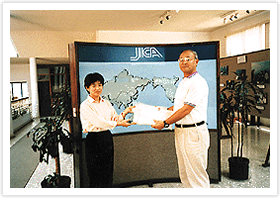Part 6: Venturing into overseas markets with telephone technologies
Japan's national income rose past prewar levels in 1955, marking the start of an era of high growth. Like many other companies, OKI invested vigorously in production equipment and R&D activities and established affiliates at home and abroad, opening a new chapter in its history as a general telecommunications manufacturer. It also devoted considerable energy to expanding operations for overseas markets.
Tackling the challenge of exporting a major plant
Initially, private sector plant investment and technical innovation drove Japan's rapid postwar economic growth, particularly in the heavy and chemical industries, creating new demand that accelerated growth. "The Japanese economy can no longer be described as postwar," declared an economic white paper in 1956 with some pride. This positive cycle energized the Japanese economy and moved it beyond its prewar high water mark.
Buoyant industrial exports from Japan fueled the Izanagi boom, which began in 1965 and lasted about five years. OKI focused its energy on overseas markets as well, believing domestic demand alone would not produce significant growth.
OKI exported telephones and telephone exchanges, especially to Asia, while looking to Latin American markets for major plant orders. As early as 1957, it participated successfully in international bidding to build a telecommunications network in El Salvador. However, Western manufacturers who had already established a presence there sought to block the entry of a Japanese enterprise, pressuring the government of El Salvador to retract a contract awarded to OKI and to solicit a new round of proposals.
Signing a contract to build a telecommunications network in Honduras

A telephone office in Tegucigalpa, Honduras
(center)
The bitter experience in El Salvador provided a crucial lesson in what was needed to succeed in international bidding. OKI realized that broader international recognition of Japan's state-of-the-art industrial technologies was required.
A second chance arrived sooner than expected. Honduras, a Latin American nation, invited international bids to construct domestic telecommunications networks, a project in which the country would commit as much as 5% of its national budget. Seeking to avoid the same mistake, OKI invited eight Honduras parliament members from both ruling and nonruling parties to Japan to demonstrate, through factory tours and other activities, the advanced state of Japan's telecommunications technologies and their parity with those of Western nations.
OKI's good-faith efforts bore fruit. In June 1962, OKI and the Honduran government concluded a contract to build a telecommunications network. OKI was tasked with building all local telephone facilities in the capital city of Tegucigalpa and in San Pedro Sula, the second largest city, as well as all microwave telecommunications facilities linking the two cities.
Venturing into overseas markets with first-rate long-distance transmission technologies
Other Japanese telecommunications manufacturers apparently received this news—that OKI had become the first Japanese manufacturer to be awarded an overseas plant contract—with surprise and admiration. Ten years before, Takeshi Kajii, the first President of Nippon Telegraph and Telephone Public Corporation founded in 1952, predicted that Japan's telecommunications technologies would give birth to an export industry, something OKI had now shown to be true.
A telecommunications plant for an overseas market requires state-of-the-art transmission technologies that meet international standards. Under the leadership of Mr. Kajii, CCITT (Comité Consultatif Internationale de Télégraphique et Téléphonique of the United Nations) standards were adopted for domestic telecommunications networks, which before the war had primarily been based on domestic technologies. OKI also vigorously promoted research on long-distance transmission technologies, producing all needed parts and components in-house and independently developing long-distance transmission technologies to meet the CCITT standards. In the Honduras project, it applied the full breadth of its world-leading transmission technologies.

Relief money presented to Honduras government
To ensure design, construction, and opening activities would proceed seamlessly on the other side of the world, OKI established a headquarters for the Honduras project as soon as it won the contract. A revolution broke out in Honduras after the project began, leading to a change in government, but the project nevertheless reached a major milestone at 12:00 a.m., December 22, 1963, with the opening of a telephone office in Tegucigalpa. Suteji Kanbe, President of OKI at the time, attended the opening ceremony and received praise from the Honduran President and ministers. At this point, 18 months had passed since the contract signing. A friendship between OKI and Honduras has continued since, and OKI has from time to time provided the country with the latest telecommunications technologies. In 1998, when a giant hurricane struck Honduras, OKI was the first Japanese company to make donations.
In 1964, the year after OKI's success in Honduras, Japan was abuzz with excitement generated by the Tokyo Olympics. Just when Japan made its presence known in international society, OKI took a major jump toward becoming a truly global company armed with sophisticated technologies.